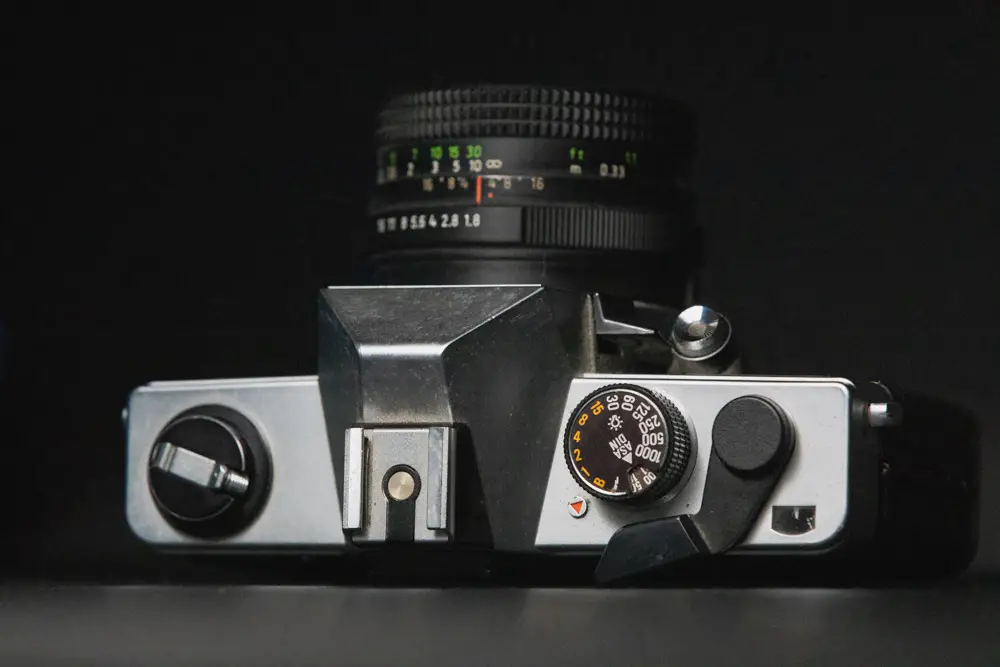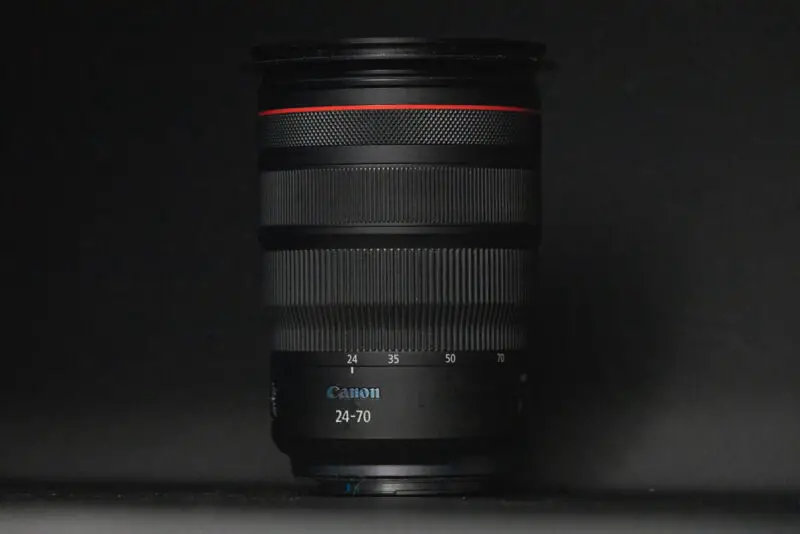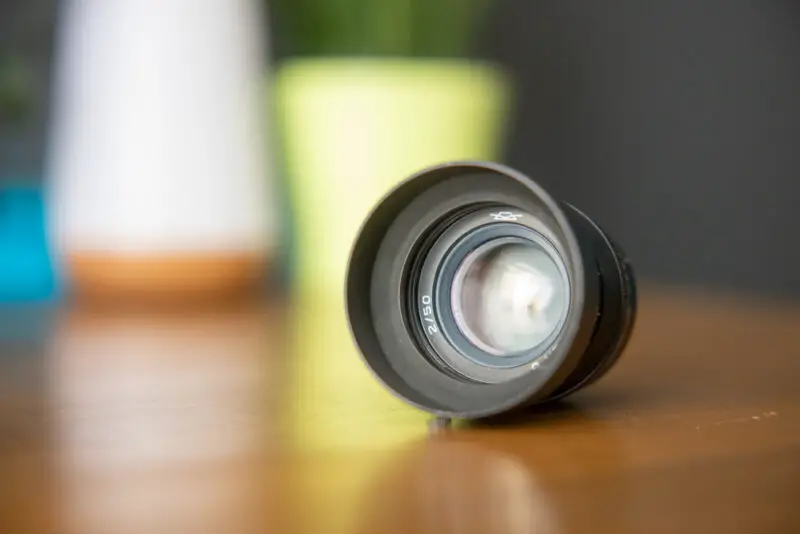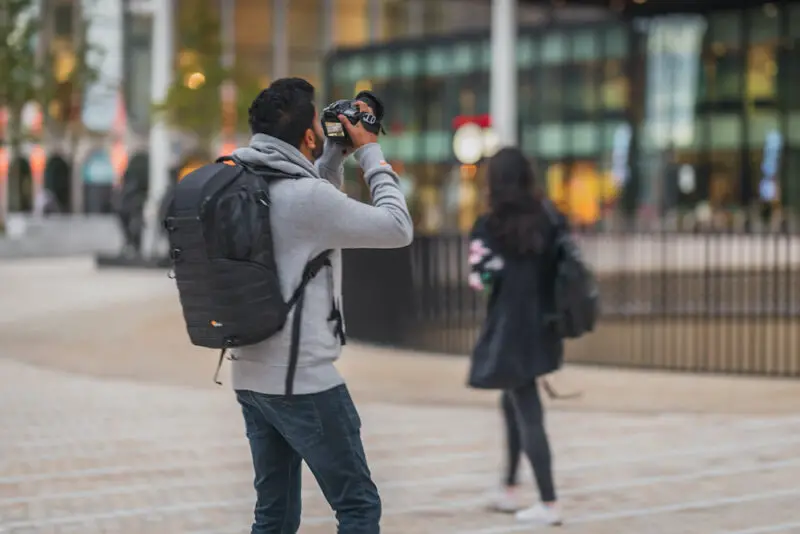So you get your first camera, and you are starting to learn the ropes. You do your homework and start figuring things out. You realize that the camera expresses shutter speed as a fraction of a second. And that the camera measures ISO by a number that indicates light sensitivity. And then you get to the aperture, which the camera expresses by the f-stop number.
But what is an f-stop actually? Before we get to that, you need to understand some basic principles about lenses.
- Lens Construction
- What Is An F-Stop?
- What Is A T-Stop?
- Which F-Stop Values Can You Use?
- Open Or Close The Aperture?
- Lens Sweet Spot
- Fancy Effects From Different F-Stops
- The F-Stop In Different Scenarios
- Summary
Lens Construction
If you pick up any lens for your camera, it will have the same parameters. It will have a maximum aperture, a minimum aperture, a focal length, minimum and maximum focal distance, a focusing system (manual or auto), and a zoom system (with zoom lenses).
Zoom lenses have variable focal lengths, meaning that they can zoom in or out between the minimum and maximum focal lengths. Prime lenses have fixed focal lengths. It means that they are devoid of a zoom mechanism. Without it, they have a simpler construction. That provides the advantage of a wider maximum aperture.
The aperture is the opening of the lens. A larger aperture means that the lens can gather more light. A smaller aperture is the opposite the lens gathers less light.
Almost all lenses can change their aperture, except for some specialty ones. More precisely, they can reduce their maximum aperture via a diaphragm or aperture blades, which reduce the size of the opening of the lens.
To know how much we reduce the aperture, we need a measurement. That measurement is the f-stop or f/ number.
But What Exactly Is An F-Stop?
In layman’s terms, f-stop or f/ number measures the aperture opening on the lens. The aperture, also known as the diaphragm, has the role of reducing the maximum width of the lens. Consequently, reducing the amount of light that the lens transmits as well.
The f-stop is a fraction that divides the width of the aperture by the focal length of the lens.
So let’s do some boring math. Let us assume that we are working with a 100mm lens. If the lens has a maximum aperture of f/2, that would mean that the aperture is 50mm wide. Because 100mm/2 = 50mm. If we dial the f/number to f/4, the aperture becomes 25mm wide. Because 100mm/4 = 25mm. The f stands for the focal length.
If we plug those settings into a camera, you will realize that even though 100/2 is twice than 100/4. The amount of light quadruples.
That is due to the surface area. The aperture is a circle (roughly), so if we plug in the width of the apertures in an area equation: A=πr², we would get that the area of f/2 = 1963.5 mm², while the area of f/4 is 490.87 mm².
As you can see, f/4 has four times lower surface area than f/2. That is why f/2 will always gather roughly four times the amount of light as f/4.
Wait, There Is A T-Stop Too?
If you are lucky to get your hands on a cine-grade lens, you will see that the aperture is written as a t-stop. Before, you were wondering what an f-stop is. Now I am throwing another term out there to confuse you.
T-stop is the more accurate brother of the f-stop. The f-stop is a geometrical measurement. Even though it is a geometrical measurement, it is not always extremely accurate because it does not account for the glass elements.
As you probably know, not all glass is created equal. If you get a 50mm f/1.4 from two different manufacturers at two different price points, one of them will be a bit brighter than the other on the same F-Stop.
That is because the glass and the coatings block or refract some of the passing light and effectively reduce the light reaching the sensor. In a cinema environment, this can be an issue. In cinema, those minute differences cost a lot of man-hours to correct, and they will cost a lot more.
That is where the t-stop comes in. The t-stop measures the light transmitted through the lens. It uses roughly the same system as the f-stop. Therefore two t/1.5 lenses will produce precisely the same brightness. This accuracy increases if the lenses are from the same manufacturer.
So, if you were to drop $16 000 on a 5 lens Sigma T/1.5 kit, at any T value, the lenses will be equally bright.
Should I Look For Cine Lenses For My Photography?
It is rare to see T-stops on a photography lens. But, the minute differences between a f/stop and a t/stop are not that big of a problem. It is just one slider correction in Lightroom/Capture One.
Additionally, cine lenses are usually manual focus lenses. Their design is for use with follow focus and power zoom motors. They have gears on them for motors to drive the focus and zoom rings.
Usually, cine lenses are made of metal. That makes them significantly heavier than their photography counterparts.
So if we compare the Sigma 18-35mm f/1.8 Art, to the Sigma 18-35mm T/2 Cine, the differences will be significant. Even though it is essentially the same lens, the Art one weighs 810 grams, while the Cine weighs 1450 grams. Almost twice as heavy. The Art one costs $699, while the Cine costs $3999.
Which F-Stop Values Can You Use?
The f/stops you can use depend on the lens itself. As previously mentioned, every lens has its own minimum and maximum aperture. For example, if we compare a Sigma 85mm f/1.4 Art to a Canon 85mm F/1.4L IS, you will notice that both lenses are 85mm, and both feature a maximum aperture of f/1.4.
Yet, the Sigma can go as low as f/16, while the Canon one can go to f/22. If you need to darken your photo, the Canon one can provide a slightly darker image than the Sigma.
Of course, as with any other camera setting, you can change the F-stop values in ⅓ of a stop increment. In lenses with declickable aperture rings, you can change the f-stop to any value.
What Happens If I Open Up Or Close The Aperture?
The f-stop value does not just affect the amount of light the lens allows to hit the sensor. Since it is a geometrical restriction, it also affects the look of the image.
What Does The F-Stop Do To Depth Of Field?
The f-stop directly controls the size of the field of focus or depth of field, if you will.
In other words, the lower the F-Stop number, the wider the field of focus is. If you want more things in focus you should close down the aperture. F/2 will have a small field of focus, while f/8 will have a significantly larger field of focus.
Additionally, if you use a crop sensor instead of a full-frame, the field of focus will appear larger. Geometrically, the field of focus is not smaller, but you are using a small portion of the photo. With that, the field of focus looks wider.
For example, if you are using a 24mm lens on a full-frame camera and a 16mm (24mm full-frame equivalent) on an APS-C camera, both at f/8, you would think you will get the same field of focus. But you will not.
The full-frame camera will have a smaller field of focus. Because the 24mm lens provides a different field of view than the 16mm lens, even though you are using a portion of the 16mm lens, it makes it appear as a 24mm lens.
What Does The F-Stop Do To Image Sharpness?
Image sharpness depends on four things: lens quality, aperture, focus accuracy, and light. Since we are talking about aperture, let us see how that affects image sharpness.
Closing down the aperture increases the lens sharpness up to a certain point. Usually, a lens on f/2 will be softer when compared to the same lens on f/8, for example. Because closing down the aperture to a higher f/number, like f/11, reduces the aberrations and refractions within the lens.
As a result, you get a sharper image with less chromatic aberration and less vignetting.
By closing down the aperture further, you will notice the photo will start to lose sharpness again, even though it has more things in focus. That happens due to diffraction. Diffraction occurs when the lens opening is so tiny that it bends the light around the edges. As a consequence, the photo loses clarity.
You have probably figured out that every lens has a sweet spot. The sweet spot, in essence, is the aperture at which the lens is the sharpest.
At What F-Stop Value Is The Sweet Spot?
Back in the day of analog photography, the rule of thumb was f/8 to f/11 is the sharpest. However, modern technology has messed that up. Lenses nowadays have different sweet spots depending on the design and manufacturer.
For example, I own a Sigma 18-35mm f/1.8 DG HSM Art lens and a Canon 85mm f/1.8 USM. The Sigma lens is sharpest at around f/2.8, while the Canon one is sharpest at near f/5.6.
Focal length is not to blame here. It is all about the lens formula. By lens formula, I mean the lens elements inside of your lens. Every lens has its own lens formula. That determines where the lens is sharpest and where it is not.
To figure out where the sweet spot on your lens is, you will have to test it out. Luckily, this is a fairly straightforward test to do.
All you need to do is put your camera on a tripod. Get a newspaper or something that has text and details on it. Make sure it is parallel to the camera. Focus on it manually until you achieve the sharpest focus.
Once you have achieved the sharpest focus, you should take pictures at every aperture value. Review the photos, and find which one is the sharpest. The aperture value on that photo is the sweet spot.
Are There Any Fancy Effects Connected To The F-Stop?
Thus far, we have focused on the technical stuff that is a consequence of playing with the f/stop. But, different f/stop values can produce a variety of creative effects.
What Is Bokeh, And What F-Stop Do I Need For It?
Have you noticed what most portrait photos have in common? Especially portraits from the modern, digital era of professional photography? It is the blurry background with those circles that form from the lights. That blurry background with circles (specular highlights) is called bokeh.
How do you achieve bokeh? You open up the aperture to the lowest f/stop number it can go. Then you get as close to your subject as possible. But make sure that you avoid wide-angle lenses.
The formula is pretty simple. The wider the aperture, the longer the focal length. The shorter the distance to the subject, the more background blur you get.
What Are Sun Stars, And How Do I Get Them?
Sun stars are those lines that burst out of the sun or bright lights in landscape photos. The chances are that you have seen many of those if you are a landscape photography aficionado. Sun stars are a product of diffraction, and to get diffraction, you need to close down the aperture. In other words, go for a larger f/ number.
Additionally, the shorter the focal length of a lens and the smaller the aperture, the more sun stars you will get. So a 20mm lens on f/16 will produce more obvious sun stars than an 85mm at f/16 would.
How Do I Manage My F-Stop In Different Scenarios?
Thus far, we discussed that the smaller the f/ number, like f/2, lets in more light. Inversely, the higher the number it lets in less light.
So what can we do with that?
What F-Stop To Choose In Low Light Scenarios?
When working in low-light scenarios, you need to increase the light hitting the sensor. You can increase the duration of the exposure or bump up the ISO. But those two can only take you so far. By opening up the aperture, you ensure that as much light as possible reaches the sensor.
This way, you can reduce the ISO to more manageable levels. Also, you can increase the shutter speed to avoid too much motion blur in the picture.
Do not be afraid to shoot the lens wide open. Even though the lens is slightly softer that way, it is not as noticeable in low light. Noise from high ISO or motion blur will degrade the sharpness of the image way more than a wide-open lens would.
That said, this compromise should be a no-brainer.
What F-Stop To Choose In Extremely Bright Scenarios?
If you were shooting film with a vintage camera, I would advise you to follow the Sunny 16 rule. Some vintage cameras have a shutter speed that can not exceed 1/250. Back in the day, photographers would use rules like this to judge exposure and avoid overexposing the film. For bright sunny days, Sunny 16 was the way to go.
Sunny 16 means that at high noon you pick f/16 and a shutter speed that matches the ASA/ISO value. So If you have ASA 200 film, your settings would be 1/200 shutter speed, f/16.
Luckily, cameras nowadays can have shutter speeds that can reach 1/8000. That means you rarely need to close down the aperture to avoid overexposure.
With most modern DSLRs and mirrorless cameras, you can pick any aperture that suits you. You compensate with the rest of the settings while using a short shutter speed and a low ISO.
What If I Am Shooting Portraits, What F-Stop Should I Use?
For portraits, mostly, you want to use a wider aperture. That means you should go for an f-stop closer to being wide open.
Personally, I tend to keep my lenses around ⅔ of a stop closed from wide open. Let’s say that I am using a Canon 85mm f/1.8 to shoot a portrait. Since it is a bit older lens, it has a lot of chromatic aberration. Because I need the bokeh to separate the subject, I set the aperture to f/2.2
That still provides for significant background separation. Additionally, it removes a lot of chromatic aberration.
That does not mean that you always need to be wide open for portraits. Sometimes there are scenarios where you need to have the background in focus as well. So it is okay to close down the aperture. Make sure you do not close down the aperture too much and lose detail due to diffraction.
How About Landscapes?
When shooting landscapes, you will be around f/8 to f/16 most of the time since you want more things in focus. As with the portraits, that does not always need to be the case.
For example, if you photograph the moon through some trees and rocks, you want them as the foreground. But if they are in focus, they will be distracting. It is okay to open up the aperture a bit in this case. That way, you can create some foreground to background separation.
Additionally, you can use hyperfocal distance to have even more things in focus. As you know by now, the more you close down the aperture, the more things you have in focus. However, proper placement of the field of focus will ensure that you have everything in focus. Or nearly everything.
There are plenty of free apps, both for the Play Store and Apple Store, that can calculate the hyperfocal distance for you. All you need to do is plug in the size of the sensor, the focal length of your lens, and the f-stop you prefer. The app will tell you at what distance you should focus.
Most lenses have a focus scale on them. Twist the focus ring until you get to the hyperfocal distance on the scale, and snap a photo. Make sure you check the photograph for focus, just in case.
So, I Am Photographing Events. What F-Stop Value Should I Use Then?
Events are tricky. Most of them are in low-light scenarios. In low-light scenarios, you should use a wide-open aperture. Or as open as you can.
When shooting events, most likely, you will be using a flash too. Most venues are too dark for the photos to look nice with just available natural light. That means you can compensate for the lack of light with the flash.
However, it does not mean that you need to put the flash on full power and shoot at f/16 all the time. Because you should separate your subjects from the crowd, a wide-open aperture works wonders in this scenario.
You will have to close down the aperture slightly when shooting groups of people. That way, you will have all the people in focus. Usually, f/5.6 does the job on a 24mm lens.
Summary
F-stop, in essence, is a weird value based on math and geometry. It controls how much light the lens lets in by closing down or opening up the aperture blades.
Additionally, it controls the depth of field, chromatic aberration, vignetting, and lens sharpness. Wider apertures provide narrower fields of focus, thus more background blur. Inversely, smaller apertures provide wider fields of focus, thus more things in focus.
If you close down the aperture to the sweet spot of the lens will remove most, if not all, of the chromatic aberration and vignetting. Additionally, it will provide a sharper image, especially in the corners.
Different scenarios call for different f/stop values. For portraits, you go for smaller f-stop values, like f/2. While for landscapes, you go for larger f-stop values, like f/11.






